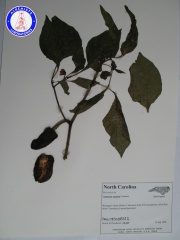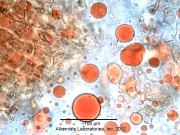Capsicum annuum (fruit)
m |
|||
| Line 27: | Line 27: | ||
=Microscopic Entries= | =Microscopic Entries= | ||
| − | {{Microscopy | source= | + | {{Microscopy | source=Elan M. Sudberg, Alkemist Laboratories |
| companyimage=AP-LOGO-Laboratories Crop - Copy.jpg | | companyimage=AP-LOGO-Laboratories Crop - Copy.jpg | ||
| companyURL=http://www.alkemist.com | | companyURL=http://www.alkemist.com | ||
| Line 35: | Line 35: | ||
| image2=Capsicum_annuum_L._var_annuum_-Solanaceae-_yellow_cells_of_testa_epidermis.jpg | | image2=Capsicum_annuum_L._var_annuum_-Solanaceae-_yellow_cells_of_testa_epidermis.jpg | ||
| caption2=Large yellow cells of the testa epidermis with wavy, strongly thickened and pitted radial inner walls viewed at 400x with Acidified Chloral Hydrate Soln. | | caption2=Large yellow cells of the testa epidermis with wavy, strongly thickened and pitted radial inner walls viewed at 400x with Acidified Chloral Hydrate Soln. | ||
| + | | reference=British Pharmacopoeia, 2011 | ||
| }} | | }} | ||
Revision as of 04:45, 3 October 2012
Contents |
Introduction
Introduction from Wikipedia, the free encyclopedia (http://en.wikipedia.org/wiki/Capsicum_annuum, retrieved 02/20/2012).
Capsicum annuum is a domesticated species of the plant genus Capsicum native to southern North America and northern South America. The three species C. annuum, C. frutescens and C. chinense all evolved from a single common ancestor located somewhere in the northwest Brazil - Colombia area. This species is the most common and extensively cultivated of the five domesticated capiscums.
The species is a source of popular sweet peppers and hot chilis with numerous varieties cultivated all around the world. In American English the plant is commonly known as a chili pepper or bell pepper.
In British English, the sweet varieties are called red or green peppers and the hot varieties chillies, whereas in Australian and Indian English the name capsicum is commonly used for bell peppers exclusively and chilli is often used to encompass the hotter varieties.
Sweet peppers are very often used as a bulking agent in ready-made meals and take-away food, because they are cheap, have a strong flavour, and are colorful. The colorful aspect of peppers increases the visual appeal of the food, making it more appetizing. Foods containing peppers, especially chili peppers, often have a strong aftertaste this is due to the presence of capsinoids in peppers. Capsaicin, a chemical found in chili peppers, creates a burning sensation once ingested which can last for several hours after ingestion.
The quoted text in this section was licensed for use under the Creative Commons ShareAlike License, version 3.0: http://creativecommons.org/licenses/by-sa/3.0/
Macroscopic Entries
|
Microscopic Entries
|
HPTLC Entries
Other Points of Interest
Cite error: <ref> tags exist, but no <references/> tag was found



